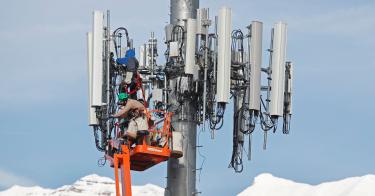Spectrum, the invisible radio frequencies over which wireless communications travel, is one of the 21st century’s most crucial resources. To protect this finite resource, Congress and the Biden administration should direct the Federal Communications Commission to ensure enough dedicated spectrum to meet surging U.S. demand for wireless.
This isn’t government overreach, but prudent stewardship.
Spectrum is classified in two ways: licensed and unlicensed. Licensed spectrum bands are allocated for commercial use by specific wireless providers through the FCC’s spectrum auctions. Tracts of spectrum go to the highest bidders, giving them exclusive rights and more control over their services, while raising money for the U.S. Treasury in the process.
On the other hand, unlicensed spectrum is free and essentially open to anyone. This makes it great for innovation, accessibility, and affordability, but less dependable when it comes to network security, congestion, and interference.
Unlicensed spectrum also is controlled by the FCC. But instead of allowing market actors to compete for spectrum, the agency is required to conduct a specific proceeding that examines the proposals of different stakeholders and then decides what spectrum bands will be designated as unlicensed.
Because of the lack of sufficient regulatory oversight and control, unlicensed spectrum provides varying levels of service quality and reliability. That fact can hinder development and deployment of applications or services that require stringent performance standards, particularly in industries such as health care or public safety where reliability is crucial.
And since unlicensed spectrum is open for shared use, it’s prone to congestion and interference in densely populated areas or in regions with high demand. That can limit its effectiveness in delivering reliable and consistent connectivity, potentially hindering innovation.
In short, unlicensed spectrum is great for the initial phases of tech development, but as we move to full implementation phases, the new tech should be migrated to licensed spectrum.
The problem right now is a looming shortage of licensed spectrum sufficient to meet wireless demand, mostly driven by the development and popularity of 5G, the fifth generation of wireless technology. The United States leads the world in 5G deployment, and a new report from the trade association CTIA predicts that 5G ultimately will add $1.5 trillion to America’s economy and contribute at least 4.5 million new jobs.
The success of this deployment comes from operators’ ability to access full-power, licensed spectrum. Yet a recent study found that the U.S. will face a licensed spectrum deficit of 400 megahertz (MHz) in the next five years. That will grow to a 1,400 MHz shortfall over the next 10 years, the study says.
Meanwhile, the process for allocating spectrum has stalled. The Federal Communications Commission’s authority to conduct auctions has expired and no clear pipeline for new spectrum allocations is evident. This situation must be remedied immediately.
A dearth of licensed spectrum for commercial providers would have a profound negative impact on our economy, society, and national security. The wireless industry supports 4.5 million American jobs and pumps about $825 billion into the U.S. economy each year.
Without wireless leadership, our ability to compete in global markets would evaporate. As 5G reaches widespread deployment, the “internet of things” will make us increasingly reliant on wireless-supported services in health care, education, public safety, and other crucial sectors.
In this competitive, high-tech world, America’s national security depends on our ability to stay on top of the latest wireless technologies.
Commerce Secretary Gina Raimondo has called for the development and implementation of a comprehensive National Spectrum Strategy, or NSS, to establish a governmentwide approach to maximizing the potential of our spectrum resources.
The government’s National Telecommunications and Information Administration is leading development of the strategy and an implementation plan in collaboration with the FCC and in coordination with other federal agencies.
The NSS should prioritize identifying spectrum for licensed, full-power commercial use. Where sharing is the only option, the strategy should focus on sharing systems that provide certainty of access for providers.
It’s critical that we identify at least 1,500 MHz of spectrum that may be repurposed for commercial use. That means a spectrum of over 1,500 MHz will need to be studied over the next 10 years.
Making more licensed mid-band spectrum available is especially crucial. The Biden administration should target the 7-8 gigahertz (GHz) spectrum band for commercial use, bringing this spectrum to market via a competitive bidding process.
This band is ripe for future deployment of 5G networks. The band’s higher capacity will allow 5G to serve densely populated areas and enable next-generation capabilities such as “smart cities.” Additionally, this band will be critical to maximizing 5G deployment going forward.
Unlicensed spectrum also plays an important role in the wireless ecosystem. But in 2020, the FCC allocated 1,200 MHz of spectrum for unlicensed use. This record increase raised eyebrows among many in the wireless community, especially as China and India indicate they’re priming this band of spectrum for 5G and 6G use.
Meanwhile, our deficit in licensed spectrum looms large over the future of America’s wireless leadership.
Prudent management by providing more licensed spectrum will keep America strong, safe, and prosperous. Congress and the administration should act to guarantee that the different agencies involved in ensuring adequate spectrum availability do their jobs well, quickly, and in a coordinated manner.
This piece originally appeared in The Daily Signal


